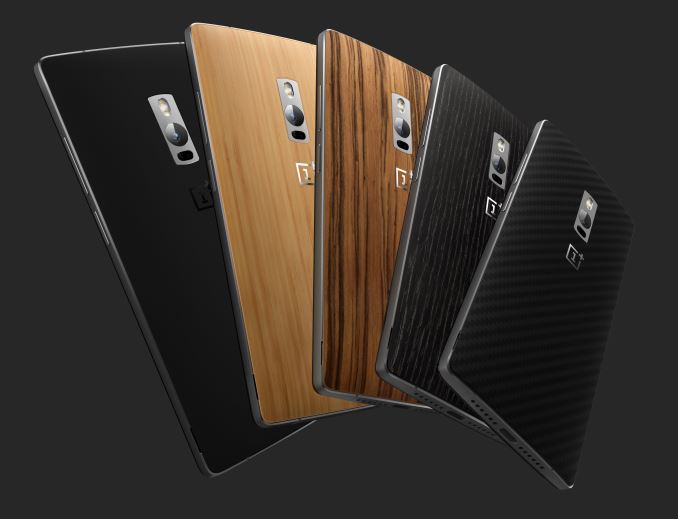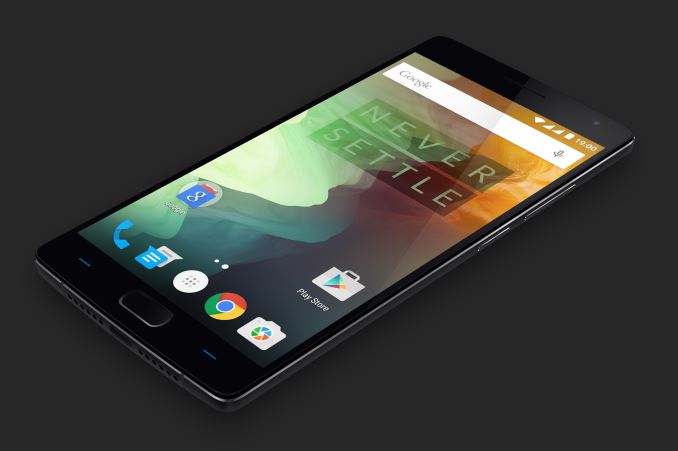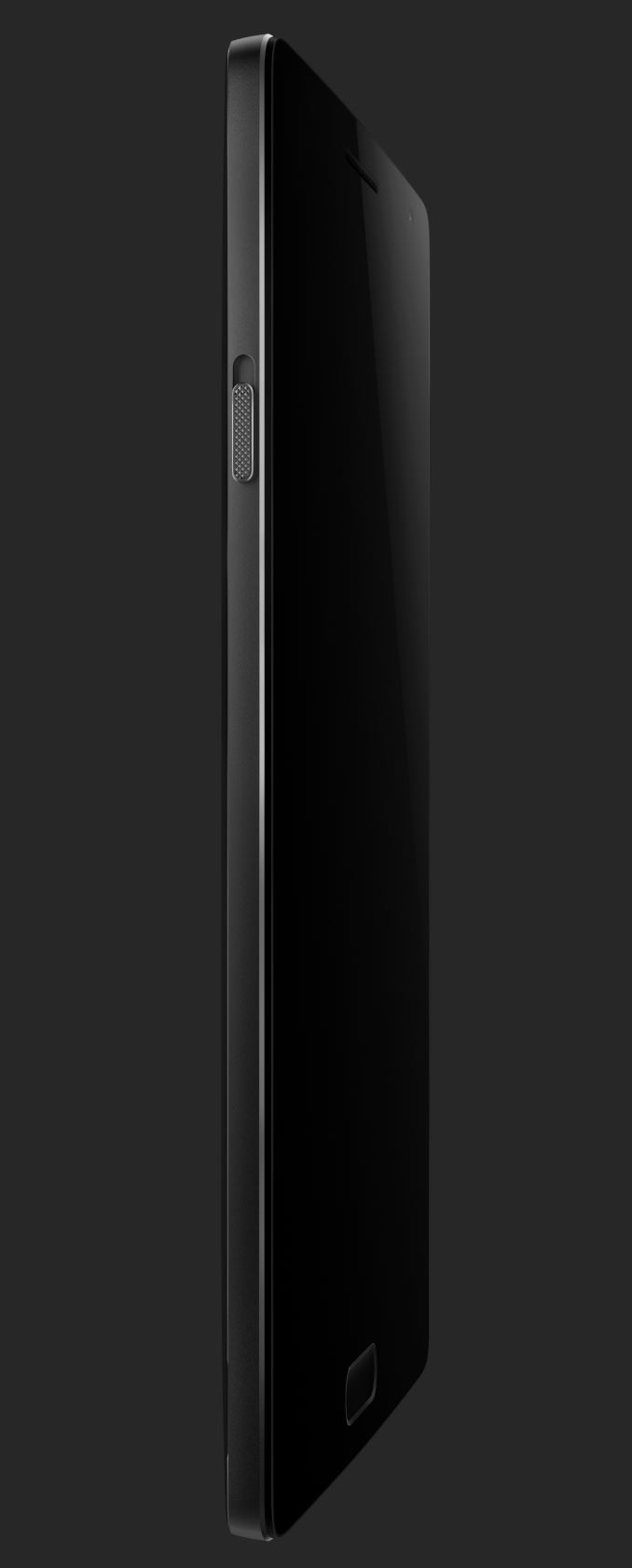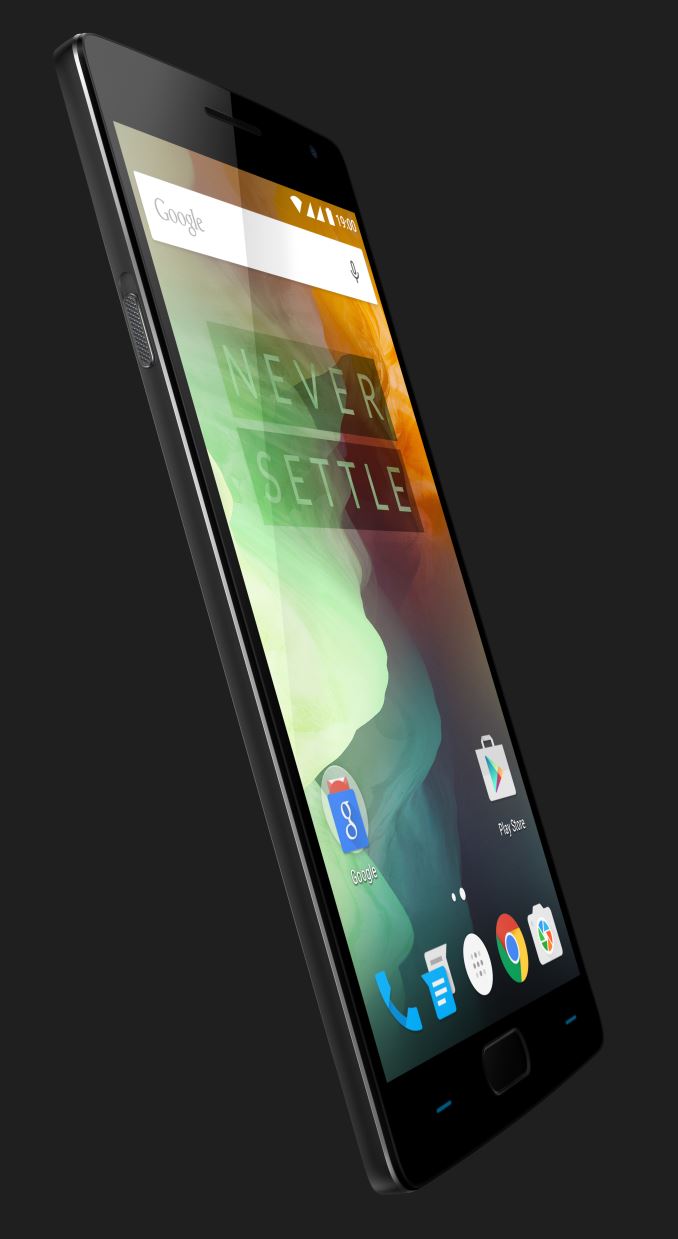OnePlus Announces the OnePlus 2: 389 USD High-End Flagship
by Joshua Ho on July 27, 2015 10:02 PM EST- Posted in
- Smartphones
- Qualcomm
- Mobile
- Snapdragon 810
- OnePlus
- OnePlus 2

OnePlus showed up on the scene last year with a “flagship killer”, the OnePlus One. For those that are unfamiliar with this device, it brought a Snapdragon 801 SoC, 5.5” 1080p display, and some generally impressive hardware at a 350USD price point for the 64GB variant. This made the OnePlus One a pretty incredible value, and to OnePlus’ credit the One remains one of the better choices in the midrange market due to its high-end specs. Today, OnePlus is launching the successor to their first device, which is called the OnePlus 2. To establish some of the basic specifications of this device I would refer to the spec table below.
| OnePlus One | OnePlus 2 | |
| SoC | Snapdragon 801 2.5 GHz Krait | Snapdragon 810 1.8 GHz A57/A53 |
| RAM | 3GB LPDDR3 | 3/4GB LPDDR4-1555 |
| NAND | 16/64GB NAND | 16/64GB NAND |
| Display | 5.5” 1080p IPS |
5.5” 1080p IPS |
| Network | 2G / 3G / 4G LTE (Category 4 LTE) | 2G / 3G / 4G LTE (Category 6/9 LTE) |
| Dimensions | 152.9 x 75.9 x 8.9mm, 162g | 151.8 x 74.9 x 9.85mm, 175g |
| Camera | 13MP Rear Facing (Sony IMX214) f/2.0, 1.1 micron 1/3.06" sensor | 13MP Rear Facing w/ OIS and laser AF, f/2.0, 1.3 micron 1/2.6" sensor |
| 5MP Front Facing | 5MP Front Facing | |
| Battery | 3200 mAh (12.16 Whr) | 3300 mAh (12.54 Whr) |
| OS | Android 4.4 w/ CM11S (At Launch) | Android 5.1 w/ OxygenOS (At Launch) |
| Connectivity | 1x1 802.11a/b/g/n/ac + BT 4.0 (WCN3680), USB2.0, GPS/GNSS, NFC |
802.11a/b/g/n/ac + BT 4.1, USB-C, GPS/GNSS |
| Fingerprint Sensor | N/A | Touch |
| SIM | 1x MicroSIM | DSDS NanoSIM |
| LTE Bands | Global: 1/3/4/7/17/38/40 | US: 1/2/4/5/7/8/12/17 EU: 1/3/5/7/8/20 |
| Launch Price | $299 (3GB/16GB) $349 (3GB/64GB) |
$329 (3GB/16GB) $389 (4GB/64GB) |
As one can see, the display size and resolution is unchanged from the OnePlus One, but OnePlus is promising higher static contrast at 1500:1, relative to the ~1000:1 contrast of the One. This is likely due to the use of photoalignment technology, which seems to have become an industry standard within the past few months. The 1080p resolution is sufficient for a 5.5” smartphone, although an increase to 1440p would be noticeable I suspect that OnePlus is responding to demands for improved battery life over higher display resolutions. The OnePlus 2 also has the somewhat standard Snapdragon 810 for a high-end smartphone, although it’s notable that the maximum frequency of the A57 cluster has been capped to 1.8 GHz in order to improve thermal performance. It isn’t clear if OnePlus is also using hotplug or other mechanisms to only use two big CPU cores either, but this will take a review to really figure out what’s going on. Battery also receives a minor size increase from 3200 mAh to 3300 mAh, presumably at a 3.8V nominal voltage. The lack of microSD expansion likely comes from user experience concerns, as is the non-removable battery. The OnePlus 2 also has a significant improvement to materials, as the frame is an alloy of aluminum and magnesium while the OnePlus One was only made of plastic on the outer casing.
The other major change is the camera. It seems that OnePlus has elected to use a 13MP, 1.3 micron camera sensor with OIS integrated into the module and laser auto focus. The 13MP 1.3 micron sensor is likely to be the OV13860, which means that the sensor format is similar to both the LG G4 and Samsung Galaxy S6, but with a larger pixel size to improve low light performance to reduce read noise from the sensor. Optical stack details remain unknown but the aperture stays at f/2.0 to balance distortion and low light performance. OIS is also introduced to improve low light photo performance for longer exposures. Laser AF is also added to reduce AF speed, a weakness that was present in the OnePlus One. Given the look of this laser AF mechanism, I suspect this is ST-M's time of flight sensor which means that this sytem will be most effective within 10cm of the laser AF sensor.
OnePlus has also introduced some new features in the form of a notification switch, fingerprint sensor, and USB-C port. The notification switch allows for fast switching between all, priority, and no notifications somewhat similar to the iPhone’s mute switch. The fingerprint sensor is also said to be better and faster than the iPhone 6’s TouchID sensor. It’s also purely capacitive, which should make it unlikely to fail over time and you can turn the phone on and unlock it only by using the fingerprint sensor, which would make the experience similar to the HTC One M9+ and Huawei Ascend Mate 7. The addition of USB-C is also great to see, as this makes OnePlus one of the first OEMs to adopt the reversible USB connector standard although it isn’t clear if all of the various features that come with USB-C will be adopted with the launch of Android M.
The OnePlus 2 will be available starting August 11 in select countries for the 64GB storage variant. The 3GB/16GB model will be 329 USD, and the 4GB/64GB model will be 389 USD. StyleSwap covers, which allow you change the back cover’s look and feel, will also be available, with black apricot, Kevlar, bamboo, rosewood, and sandstone black options.














90 Comments
View All Comments
Huacanacha - Tuesday, July 28, 2015 - link
Why not just call it the Three?vMalign - Tuesday, July 28, 2015 - link
After watching the awesome VR release and finding out this flagship is only going to be $320 USD, this is a phone that I think is one of the best ones you will ever find with such an unbeatable price.Sadly OnePlus Two still runs off an invite only system, so you have to register your email here (https://oneplus.net/invites?kolid=VSFN53) to be put in the queue to get the phone. (Also, if you share this link you get bumped up in the queue!)
adityarjun - Tuesday, July 28, 2015 - link
Are you an OPO employee? Or hired by them in anyway?cfenton - Tuesday, July 28, 2015 - link
Looks like a good deal, but it's too bad they are still using the invite system. If have to get on a waiting list for a product, I'm just going to buy something else. It's not like there's a lack of other good phones, and I can walk into a store and buy those.Redhavoc - Tuesday, July 28, 2015 - link
I find Anandtechs comment "The 1080p resolution is sufficient for a 5.5” smartphone, although an increase to 1440p would be noticeable" to be unfortunate. I was expecting better from a site that is fully aware of technology and should be able to tell the difference of a real feature and a marketing hype. 1440p at this screen size adds no benefit to the user (unless the reviewer can tell the pixels apart on a 400DPI screen on a distance of 30cm+), and has only drawbacks (increased power consumption and increased graphics performance demands).If your statement is true then those iphones must be very bad devices since their resolutions are ridiculously low for the size with a dpi of 326. But they are very close at the sweet sport for most if not all of us.
Maxpower2727 - Tuesday, July 28, 2015 - link
Quite a few people (myself included) can easily tell the difference between 1440p and 1080p at this size and can appreciate the additional resolution. Don't take your own experience and opinions and try to make them universal.Redhavoc - Wednesday, July 29, 2015 - link
Being able to tell the difference in display quality/colour and brightness is understandable. According to theory this display is way above the retina standards, so either you and your friends have much above visual capabilities, or you are looking at the phone closer than you should be. But if you say you can tell the difference I take your word.One aspect they never touch is the drawbacks of having a bigger display. And the difference is big. it requires bigger more powerful and power hungry GPUs, and more power draw from the display PMU. A similar thing is happening in other areas, with SoCs at ridiculous amounts of cores and unnecessary high frequencies, again persuing marketing gains. The benefits of most of them will only appear in benchmarks. Look again how competitive the iphone SoC is which has gone wide and low frequency. The power consumption is much reduced for comparative in performance.
The real pros and cons have never been highlighted in many of those reviews giving a free hand to marketing to direct the technology departments to the wrong place.
Wardrop - Tuesday, July 28, 2015 - link
Yeah no NFC is a major bummer. I mean, you never know what applications are going to be available for technology like that. It was only in last few months that my bank enabled NFC payments in their Android app. Now I can pay with my phone almost anywhere. It's like bluetooth, even if you don't use it now, it doesn't mean you won't start using it 3 months when you get a new car or something.gsv619 - Wednesday, July 29, 2015 - link
Check the link below to get OnePlus 2 invites...https://oneplus.net/in/invites?kolid=KZNYJ1
Madpacket - Friday, July 31, 2015 - link
Sorry but the OPO has been replaced by the Asus Zenphone 2 IMO as the value leader.